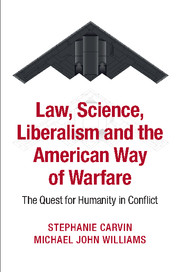Book contents
- Frontmatter
- Contents
- Prologue
- Introduction
- 1 Law and science in the Western way of war
- 2 The American way of war
- 3 Vietnam and the “science” of war
- 4 Immaculate destruction: reorganization, revolution and re-enchantment of War
- 5 Revolution denied: the “war” on terror
- 6 Back to the future?
- Index
- References
1 - Law and science in the Western way of war
Published online by Cambridge University Press: 05 December 2014
- Frontmatter
- Contents
- Prologue
- Introduction
- 1 Law and science in the Western way of war
- 2 The American way of war
- 3 Vietnam and the “science” of war
- 4 Immaculate destruction: reorganization, revolution and re-enchantment of War
- 5 Revolution denied: the “war” on terror
- 6 Back to the future?
- Index
- References
Summary
The Greeks, I have learned, are accustomed to wage wars in the most stupid fashion due to their silliness and folly. For once they have declared war against each other, they search out the finest and most level plain and fight it out. The result is that even the victors come away with great losses; and of the defeated, I say only they are utterly annihilated.
Mardonius explaining the Greeks to the Persian king Xerxes as recorded by Herodotus in The Histories (7.9.2)Nevertheless, as civilization has advanced during the last centuries, so has likewise steadily advanced, especially in war on land, the distinction between the private individual belonging to a hostile country and the hostile country itself, with its men in arms. The principle has been more and more acknowledged that the unarmed citizen is to be spared in person, property, and honor as much as the exigencies of war will admit.
US Union Army, General Orders 100, Article 22, 1863A visitor from foreign lands to the American capital city of Washington D. C. is immediately struck by the classical design of the city and its monuments. From the ionic columns of the Jefferson Memorial set on the Tidal Basin, to the thirty-six fluted Doric columns of the Lincoln Memorial perched upon high ground overlooking the reflecting pool and the singular column of the Washington Monument, the architecture of America’s capital city reflects a bygone era. The city recalls a vision of Imperial Rome, itself a copy of the magnificent Greek city-states of the fourth and fifth centuries BC. While the architecture of the US capital recalls these ancient civilizations, the very idea that Washington embodies – democracy – is a more important link to these ancient civilizations. The members of the US House and Senate, duly elected by free citizens, to create laws to order society, laws that in turn are upheld by an independent judicial system, act in a cultural fashion shaped first by the ancient Greeks and later by ancient Rome.
- Type
- Chapter
- Information
- Law, Science, Liberalism and the American Way of WarfareThe Quest for Humanity in Conflict, pp. 21 - 54Publisher: Cambridge University PressPrint publication year: 2014



